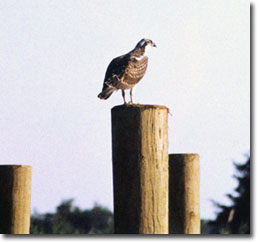Osprey
Pandion haliaetus
 At the top of the Chesapeake Bay's food chain soars one of North America’s largest birds of prey and one of the most widespread birds on earth: the osprey.
At the top of the Chesapeake Bay's food chain soars one of North America’s largest birds of prey and one of the most widespread birds on earth: the osprey.
At about 24 inches tall with a wingspan of up to six feet, the oft-called fish hawk has no predators but competes with the bald eagle for food. With a diet consisting almost exclusively of live fish, these large raptors hover over the water at an altitude of 50 to 200 feet, diving in feet first to catch their prey.
The osprey is an avid collector. Its conspicuous nests, found atop dead trees, channel markers and telephone poles, have been known to include rubber boots, bicycle tires, Hula Hoops, television antennae, Styrofoam cups and plastic containers in construction -- just one more important reason to keep our waterways and landscapes clean, and free of trash and debris.

Once nearly eradicated in the Chesapeake region -- widespread use of pesticides pre-1972 resulted in eggs too frail to survive – today there are more than 2,000 nesting pairs in the bay area. Ospreys mate for life.
See them up close!
Ospreys, or "fish hawks," are common from the spring through the fall at
Blackwater National Wildlife Refuge. They use nesting platforms that have been placed throughout the marsh. Osprey and eagle interactions are interesting due to their competition for fish resources. You can see them live when they're nesting on the
Osprey Cam.
Photo of Osprey
(Pandion haliaetus) on pier pilings courtesy of
Mary Hollinger, NODC biologist, NOAA's America's Coastlines Collection